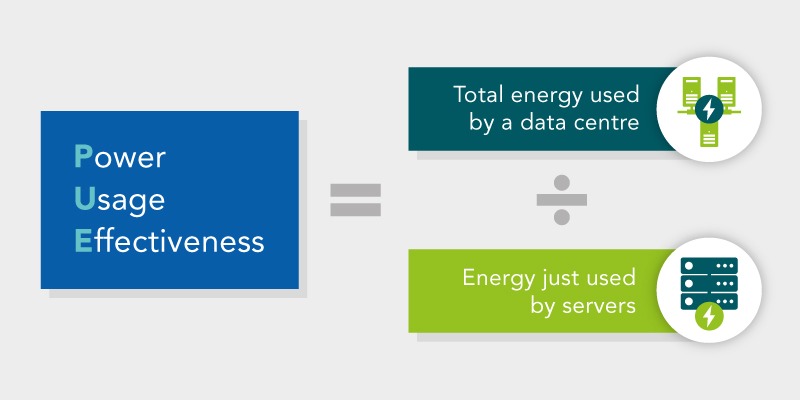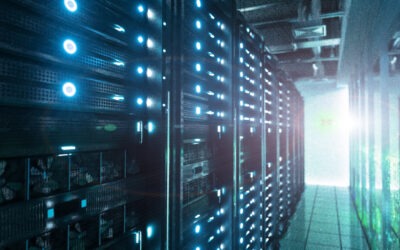With efforts to tackle climate change ramping up, companies are feeling increased pressure to adopt greener business processes. It’s not just customers expecting more; ESG reporting is becoming more important to investors as they prioritise commitments towards carbon neutrality. We at Redcentric understand that environmental impact is a top consideration for our data centre customers, which is why we’re committed to sustainable practices and technologies.
Committed to renewable energy
We purchase 100% renewable energy to power our data centres, and have been doing so for over a decade, since 2011.
Redcentric’s PUE Score
Power Usage Effectiveness (PUE) is the standard way of measuring a data centre’s energy efficiency. Each data centre has a PUE score, which should be as low as possible, with 1 being the theoretically perfect score.
A PUE score is calculated like this: PUE Score = Total energy used by a data centre ÷ Energy just used by servers
So, the less energy a data centres uses to operate all of its facilities the lower their PUE score will be.
With all of our sustainable technologies and policies we have been able to achieve a PUE at Redcentric of 1.14. This is significantly lower than the global average of 1.57.
Redcentric’s advanced cooling technologies
When it comes to running servers, the vast majority of power consumed – other than what is used to power the servers themselves – goes towards keeping them cool. As such, boosting the efficiency of cooling systems is an opportunity to significantly reduce the amount of energy IT systems need.
At Redcentric we have developed our cooling systems using cutting edge technology to ensure we offer one of the greenest data centres in the world.
1. Cold-aisle containment
There are many different ways for data centres to deliver cooling to the servers on their data floors. At Redcentric one way we do this is using cold-aisle containment which forces cool air over servers rather than escaping:
- Our server racks make up the walls of our cold aisles, with doors and a roof sealing the corridor
- Chilled air is delivered through the floor into the aisle.
- Since it has nowhere else to go, the chilled air is forced through the walls of the corridor, and over the servers.
This efficient process reduces the amount chilled air we need to produce since none of it is wasted, and so reduces the energy we use in our cooling system.
2. Adiabatic cooling towers
Our adiabatic cooling towers are one of the ways we generate our chilled water. They use the natural process of evaporation to cool the water down, so the only power used is to pump the water through the towers. Evaporation is the same process that cools humans when we sweat.
These cooling towers can keep up with cooling our data floor, even on the hottest days of the year. And we have built our towers with a modular design, so that as we increase the servers we have in the data centre, can install more towers and continue to use this highly efficient cooling.
3. Immersion cooling hosting
Immersion cooling is a very new technology where servers are submerged into a mineral oil which doesn’t conduct electricity. This means liquid can be put into direct contact with the servers to deliver cooling and remove heat. We can connect up immersion cooling tanks to our existing chilled water supply to host them on the data floor, one of the few colocation data centres in the UK to offer this service.
Immersion is more efficient than using chilled air and can be used to cool incredibly dense server setups, with power draw of up to 100kW in a single rack. So if you’re looking to deploy HPC to run AI or advanced analytics, immersion cooling hosting might be the best fit for you
Other sustainable technologies and policies
We didn’t stop with cooling. At Redcentric we have done everything we can to reduce our environmental impact and so have introduced sustainable technologies and policies into every aspect of how our data centres operate.
1. Efficient UPSs
Uninterruptible Power Supplies (UPSs) are equipment that protect data centres from power failures. They are effectively huge batteries that power the data centre while generators kick in. All of the electricity supply for a data centre will go through their UPSs, and an unfortunate side effect of this is lost energy as it passes into and out of the batteries.
However, at Redcentric, we have invested in state-of-the-art UPSs with line-interactive / ‘Smart Active’ efficiency of up to 98.5%. This means only 1.5% of energy is lost in the transfers, significantly less than data centres with less efficient UPSs.
2. LED lights on motion detectors
Reducing energy consumption goes beyond just the data floor. Throughout our data centres we have energy-efficient LED bulbs.
These are also fitted with motion detector switches, so that they turn off automatically when no one is using a room.
3. Recycling for customers
Since we host IT equipment for our customers, we also get a lot of this equipment shipped to the data centre. Whenever there’s cardboard or other recyclable packaging, we take care of this for our customers to ensure everything that can be recycled is.
So, if you want to work with one of the greenest data centres in the world, to save money on energy costs and achieve your ESG goals, get in touch to get advice from an expert on how we can help.


